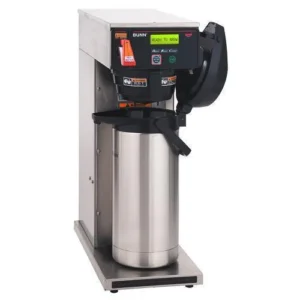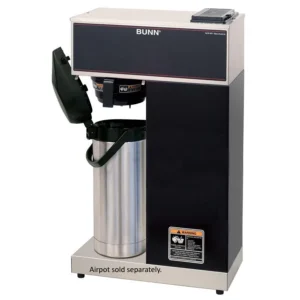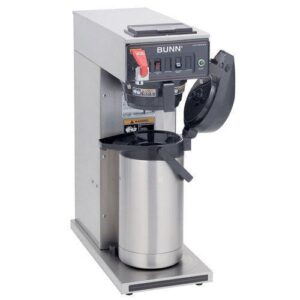Meeting the Coffee Challenge
It’s 8:45 AM at the Anderson-Miller wedding reception. The ceremony finished beautifully, and 175 guests are now entering the banquet hall for breakfast. The mother of the bride approaches you, the catering manager, with concern in her eyes: “Everyone’s asking about coffee. Will there be enough? And will it stay hot through the three-hour reception?”
For professional caterers, this scenario represents one of the most common challenges: providing quality coffee service at scale while maintaining temperature, flavor, and convenience throughout an event. Whether you’re handling corporate functions, weddings, conferences, or other gatherings, your coffee service capabilities can significantly impact client satisfaction and your reputation.
This is where a commercial automatic airpot system enters the picture—transforming how caterers approach beverage service with efficiency, consistency, and flexibility that traditional coffee service methods simply can’t match.
Understanding Airpot Coffee Systems
What Are Airpot Coffee Systems?
Airpot coffee systems consist of two primary components: a commercial-grade brewing unit and insulated airpot dispensers. The brewing units are designed specifically to brew directly into portable airpots rather than traditional glass carafes or large urns.
These systems differ from traditional coffee service equipment in several key ways:
- Thermal Efficiency: Airpots use vacuum insulation technology to maintain coffee temperature without requiring continuous heating, preserving flavor while eliminating scorching.
- Portability: Unlike bulky coffee urns or stationary dispensers, airpots can be distributed throughout an event space, creating multiple service points.
- Modular Design: Systems can be scaled up or down depending on event size by simply adding or removing airpots.
- Fresh Brewing Capability: Many systems allow for staggered brewing throughout an event, ensuring freshness without sacrificing volume capacity.
Common Airpot System Configurations
The most widely used configurations in catering environments include:
- Single Brewer with Multiple Airpots: One brewing unit that sequentially fills 1.9-2.5 liter airpots, ideal for smaller events under 100 guests.
- Twin Brewing Systems: Dual independent brewing heads allow simultaneous preparation of two different coffee varieties, effectively doubling production capacity.
- Multi-Station Systems: Multiple brewing units positioned at preparation areas that feed into a central distribution point, suitable for very large events exceeding 500 guests.
- Satellite Systems: A central brewing unit with airpots distributed to multiple remote service stations, perfect for events spread across different rooms or floors.

PureCoffeeCraft is a participant in the Amazon Services LLC Associate Program, an affiliate advertising program created for sites to earn fees by advertising and linking to Amazon. If you are making a purchase at Amazon today, please click on one of my links. There is no extra cost for consumers who purchase from links.
Operational Benefits for Catering Professionals

Production Volume and Efficiency
Commercial airpot systems dramatically outperform traditional coffee making approaches in terms of volume efficiency. Here’s why this matters in catering contexts:
- Continuous Production Capability: High-end systems like the Bunn Axiom Twin or FETCO CBS-2132XTS can produce 15-20 gallons (240-320 cups) per hour, meeting the immediate needs of large groups.
- Reduced Labor Requirements: An efficiently designed airpot station can be managed by a single staff member, freeing other personnel for different service needs.
- Rapid Service Capability: When guests arrive simultaneously (common during breaks at conferences or between ceremony and reception), pre-filled airpots eliminate service bottlenecks.
- Predictable Production Timing: Digital brewing systems provide precise timing for each batch, allowing caterers to schedule production into their event timelines accurately.

Temperature Management and Quality Control
Temperature stability represents one of the most significant challenges in coffee service. Airpot systems address this challenge through:
- Extended Heat Retention: Quality airpots maintain serving temperature (185-190°F) for 2-4 hours without additional heating, preventing the common catering problem of tepid coffee.
- Elimination of Scorching: Unlike traditional heated urns where coffee continues cooking after brewing, airpots preserve the coffee’s flavor profile by avoiding sustained heat exposure.
- Consistent Extraction: Commercial grade brewing units provide precise temperature and volume control during extraction, ensuring flavor consistency from the first cup to the last.
- Serving Temperature Safety: The exterior of quality airpots remains cool to touch despite the hot contents, reducing burn risks for both staff and guests.

Logistical Flexibility and Space Utilization
Catering often involves adapting to challenging venues with space constraints. Airpot systems provide logistical advantages including:
- Reduced Footprint: A twin brewing system with six airpots can serve 300+ guests while occupying only about 4 square feet of preparation space.
- No Power Requirements at Serving Points: Unlike heated dispensers, airpots require no electrical connections at serving stations, allowing placement anywhere.
- Transport Efficiency: Filled airpots can be safely transported in standard catering vehicles without specialized equipment.
- Adaptable Serving Arrangements: Coffee stations can be reconfigured during events without disrupting service, adapting to changing guest flow patterns.
Financial Considerations for Catering Operations
Investment Analysis: Costs and Returns
Integrating airpot systems into a catering operation requires careful financial consideration:
Initial Investment Components:
- Commercial brewing units: $1,200-$4,500 depending on capacity and features
- Quality airpots: $75-$150 per unit (3-10 typically needed)
- Supporting equipment (water filtration, stands): $200-$500
- Total typical investment: $2,500-$7,000 for a complete system
Operating Cost Factors:
- Lower energy consumption compared to continuously heated systems
- Reduced coffee waste through better temperature management
- Lower labor costs through operational efficiency
- Maintenance requirements: descaling, gasket replacement, regular cleaning
Return on Investment Calculation: For a mid-sized catering operation serving 100 events annually, airpot systems typically show full ROI within 12-18 months through:
- Ability to service larger events without rental equipment
- Reduced coffee waste (20-30% improvement over traditional methods)
- Labor savings of approximately 25-30 minutes per event
- Extended equipment lifespan (7-10 years for quality systems)
Differentiation and Premium Service Opportunities
Beyond basic cost analysis, airpot systems create opportunities for service enhancement and revenue generation:
- Coffee Bar Upgrades: The flexibility of multiple airpots enables offering premium coffee options (single-origin, specialty roasts) as upsell additions to standard packages.
- Custom Branding: Many airpots can be customized with client logos or event themes as a premium service offering.
- Self-Service Efficiency: Airpots’ intuitive operation allows for elegant self-service coffee stations, reducing staffing requirements without compromising quality.
- Extended Service Capabilities: The ability to maintain temperature longer extends coffee service throughout events rather than limiting it to meal periods.
Service Ideas, Inc. YouTube Channel
Menu Development and Coffee Program Enhancement
Expanding Coffee Offerings Through Variety Management
Airpot systems fundamentally change what’s possible for catering coffee programs:
- Multiple Variety Service: Twin brewing systems allow simultaneous production of dark and light roasts or regular and decaffeinated options without quality compromise.
- Specialty Coffee Integration: The precision brewing controls found on commercial airpot systems enable proper extraction for specialty coffee beans that might be ruined in conventional equipment.
- Regional and Seasonal Programs: Caterers can develop rotating coffee programs featuring regional roasters or seasonal flavors, creating marketing differentiation.
- Custom Blends: Some catering operations work with local roasters to develop proprietary blends as signature offerings, made possible by the extraction precision of commercial brewers.
Complementary Offering Development
The operational efficiency gained through airpot systems creates opportunities to enhance accompanying offerings:
- Enhanced Condiment Stations: The reduced labor needed for coffee management allows more attention to creating premium condiment displays including:
- Flavored syrups and artisanal sweeteners
- Non-dairy milk alternatives
- Flavor-infused creams
- Spice selections (cinnamon, nutmeg, cardamom)
- Paired Food Offerings: Efficient coffee service creates opportunities for developing complementary food pairings marketed as complete packages:
- Morning breaks with artisanal pastries
- Afternoon service with chocolate and biscotti
- After-dinner service with dessert flights
Practical Implementation Strategies
Space Planning and Workflow Design
Effective implementation of airpot systems requires thoughtful space planning:
Preparation Area Requirements:
- Water source with appropriate pressure (20-90 PSI)
- Adequate electrical capacity (typically 20-30 amp dedicated circuits)
- Counter space for brewing unit (approximately 2-3 feet wide)
- Storage area for empty airpots and supplies
- Access pathways for staff movement during peak production
Serving Area Considerations:
- Stable, level surfaces for airpot placement
- Space allocation for condiments and accompaniments
- Traffic flow patterns that prevent congestion
- Visual accessibility for guests to identify coffee varieties
- Protection from environmental factors (direct sunlight, drafts)
Workflow Optimization Techniques:
- Pre-event preparation checklist
- Production scheduling based on consumption patterns
- Rotation systems for airpot refilling
- Designated staff responsibilities
- Quality control sampling procedures
Training Protocols for Consistency
Staff training significantly impacts the success of airpot coffee service:
Key Training Components:
- Proper brewing parameter setting for different coffee varieties
- Airpot preparation and pre-heating techniques
- Cleaning and maintenance procedures
- Quality assessment standards
- Troubleshooting common issues
Standard Operating Procedures Development: Creating documented SOPs ensures consistency across events and staff changes:
- Step-by-step brewing instructions with visual guides
- Coffee-to-water ratio standards for different event types
- Temperature verification processes
- Cleaning protocols and schedules
- Quality verification checklists
Advanced Applications for Specialized Events
Corporate Event Optimization
Corporate events present specific requirements that airpot systems can address:
- Schedule Synchronization: Timed brewing to align with agenda breaks
- Branded Experiences: Custom airpot wrappers or stands featuring corporate logos
- Extended Service Requirements: Maintaining freshness through day-long conferences
- Multiple Location Management: Serving different meeting rooms simultaneously
- VIP Service Integration: Special varieties for executive areas
Wedding and Social Event Applications
Social events benefit from the aesthetic flexibility of airpot systems:
- Design Integration: Incorporating airpots into event décor themes
- Service Timeline Management: Maintaining quality from post-ceremony through reception
- Guest Flow Optimization: Strategic placement to prevent service bottlenecks
- Late-Night Service: Fresh brewing for end-of-event service
- Custom Beverage Programs: Signature coffee blends matching couple preferences
Large-Scale Event Management
For events exceeding 500 attendees, airpot systems require strategic deployment:
- Production Scheduling: Staggered brewing timelines to ensure freshness
- Distribution Networks: Systems for transporting filled airpots to multiple locations
- Consumption Tracking: Monitoring usage to predict refill requirements
- Backup Planning: Contingency arrangements for unexpected consumption patterns
- Staff Communication Systems: Coordinating between brewing and serving areas
Sustainability Considerations
Environmental Impact Reduction
Airpot coffee systems offer several sustainability advantages over alternatives:
- Energy Efficiency: Thermal insulation rather than continuous heating reduces energy consumption by 30-50% compared to traditional heated urns.
- Waste Reduction: Precise brewing controls and better temperature management reduce coffee waste. Additionally, the elimination of individual serving packages (common with single-cup brewers) significantly reduces packaging waste.
- Water Conservation: Modern brewing systems feature precise water metering, eliminating the excess water usage common with manual filling methods.
- Equipment Longevity: Quality airpot systems have significantly longer service lives (7-10 years) than consumer-grade equipment, reducing resource consumption through replacement.
Communicating Sustainability to Clients
Growing client interest in sustainable practices creates marketing opportunities:
- Efficiency Messaging: Highlighting the reduced energy and water consumption of airpot systems
- Waste Reduction Metrics: Quantifying the packaging waste avoided compared to single-serve alternatives
- Local Sourcing Integration: Partnering with local roasters to reduce transportation impacts
- End-of-Life Planning: Implementing recycling programs for coffee grounds and related materials
Troubleshooting Common Challenges
Quality Control Issues
Even well-designed systems encounter occasional problems:
Common Issues and Solutions:
- Temperature Inconsistency
- Causes: Inadequate pre-heating, damaged gaskets, improper lid closure
- Solutions: Implement pre-heating standards, regular gasket inspection, staff training on proper closure techniques
- Flavor Degradation
- Causes: Excessive hold times, improper cleaning, water quality issues
- Solutions: Establish maximum hold time standards, develop thorough cleaning protocols, install appropriate water filtration
- Volume Shortfalls
- Causes: Inaccurate consumption projections, brewing delays, unexpected attendance
- Solutions: Develop consumption models based on event type, create rapid response procedures, maintain reserve brewing capacity
Logistics and Service Flow Problems
Operational challenges typically fall into predictable categories:
Identification and Resolution:
- Service Bottlenecks
- Causes: Insufficient serving points, poor guest flow design, inadequate signage
- Solutions: Multiple serving stations, directional traffic management, clear variety identification
- Refill Coordination
- Causes: Poor communication, inadequate monitoring, staff allocation issues
- Solutions: Designated coffee captains, systematic monitoring procedures, wireless communication systems
- Transport Challenges
- Causes: Inadequate carriers, distance between preparation and service areas, venue layout constraints
- Solutions: Purpose-designed transport equipment, satellite brewing stations, venue-specific planning
Future Trends in Airpot Coffee Catering
Technological Advancements
The catering coffee landscape continues to evolve with several emerging trends:
- IoT Integration: Connected brewing systems that monitor consumption, predict refill timing, and optimize brewing schedules
- Mobile Control Interfaces: Smartphone applications allowing remote monitoring and control of brewing parameters
- Enhanced Thermal Technologies: New insulation materials extending temperature maintenance beyond current limitations
- Custom Brewing Programs: Systems allowing parameter adjustment for specific coffee varieties to optimize extraction
Service Model Evolution
Changing client expectations are reshaping service approaches:
- Coffee Sommelier Services: Dedicated specialists managing coffee service as premium additions to catering packages
- Interactive Coffee Experiences: Educational elements incorporated into coffee service as engagement features
- Multi-Beverage Integration: Systems handling both coffee and tea programs through the same equipment
- Direct Farm Relationship Programs: Traceable coffee sources as premium offerings highlighting producer stories
Conclusion: Strategic Implementation for Catering Success
Airpot coffee systems represent far more than merely convenient equipment—they offer a strategic approach to beverage service that can transform operational capabilities, enhance client experiences, and create competitive advantages for catering businesses.
The most successful implementations share common characteristics:
- Systematic Planning: Thoughtful integration into overall catering operations rather than isolated equipment purchases
- Staff Investment: Comprehensive training that emphasizes quality standards and technical understanding
- Quality Prioritization: Recognition that coffee service quality significantly impacts overall event perception
- Continual Refinement: Ongoing evaluation and improvement of coffee programs based on client feedback and consumption patterns
For catering operations seeking to elevate their beverage service while improving operational efficiency, airpot coffee systems provide a versatile foundation upon which to build distinctive, quality-focused offerings that meet modern client expectations while supporting business growth objectives.
Whether you’re managing intimate gatherings or large-scale events, the flexibility, quality control, and operational advantages of properly implemented airpot systems can transform how your operation approaches coffee service—turning a traditional catering challenge into a signature strength.